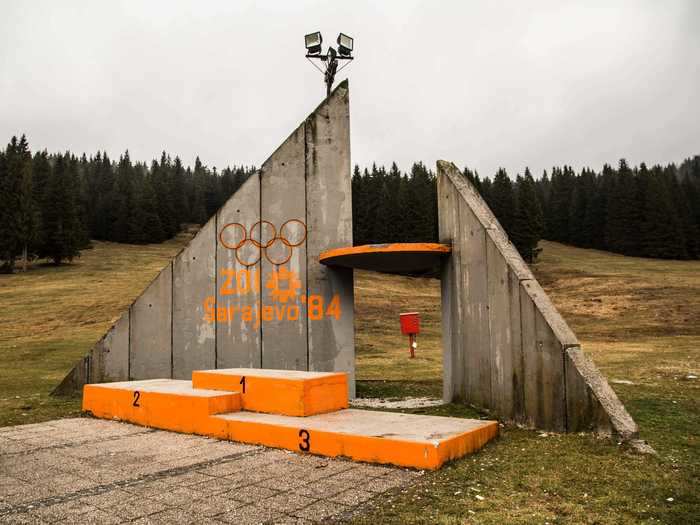
The abandoned shell of a hotel constructed for the 1984 Winter Olympics where competitors stayed.Giles Clarke/Getty Images

The 1984 games were the first Winter Olympics to be held in a socialist state, and the second consecutive games to be held in a socialist country, after the 1980 Summer Olympics in Moscow.

The US boycotted the games in Moscow in response to the Soviet invasion of Afghanistan in 1979. More than 60 nations refused to take part.
In 1984, many of the events took place near Jahorina Mountain, seen here in 2019.

A destroyed hotel at Mount Igman, where events including ski jumping were held in 1984, is pictured in 2014.

This is what the bobsled track looked like in 2014 — it's been almost completely left to nature.
Sylvia Hui at the Associated Press wrote that year, "Today, the abandoned concrete construction looks like a skeleton littered with graffiti."

According to NPR, the Bosnian war led to 100,000 deaths and the "worst atrocities in Europe since World War II."

According to Getty, 10 years after the games, "the hotel was turned into a prison and place of execution for Bosnian Muslims — all overseen by Serb Forces." Even the medal podium was turned into an execution site.

Many of the Olympic venues had been damaged or destroyed by the constant bombing and warfare.

According to Getty, "The area around the 90-meter hill was heavily mined during the Bosnian war."

The mountains border the city.

Vertigo sufferers might want to look away.

They're just missing some color.

East Germany's Jens Weißflog and Finland's Matti Nykänen each took home gold medals in ski jumping that year.

"The remains of destroyed restaurants, hotels, sports facilities and mountain huts were left to rot and the thousands of mines were cleared at a painstakingly slow pace" after the war ended, The Guardian wrote in 2018.
The cable car triumphantly reopened in 2018.

At least it's getting some use.

The walls are covered in tags and street art.

It's probably harder to bike in that weather.

Unfortunately, Sarajevo isn't the only city that has to reckon with abandoned Olympic venues. There are empty stadiums all over the world.
 Stock markets stage strong rebound after 4 days of slump; Sensex rallies 599 pts
Stock markets stage strong rebound after 4 days of slump; Sensex rallies 599 pts
 Sustainable Transportation Alternatives
Sustainable Transportation Alternatives
 10 Foods you should avoid eating when in stress
10 Foods you should avoid eating when in stress

Copyright © 2024. Times Internet Limited. All rights reserved.For reprint rights. Times Syndication Service.